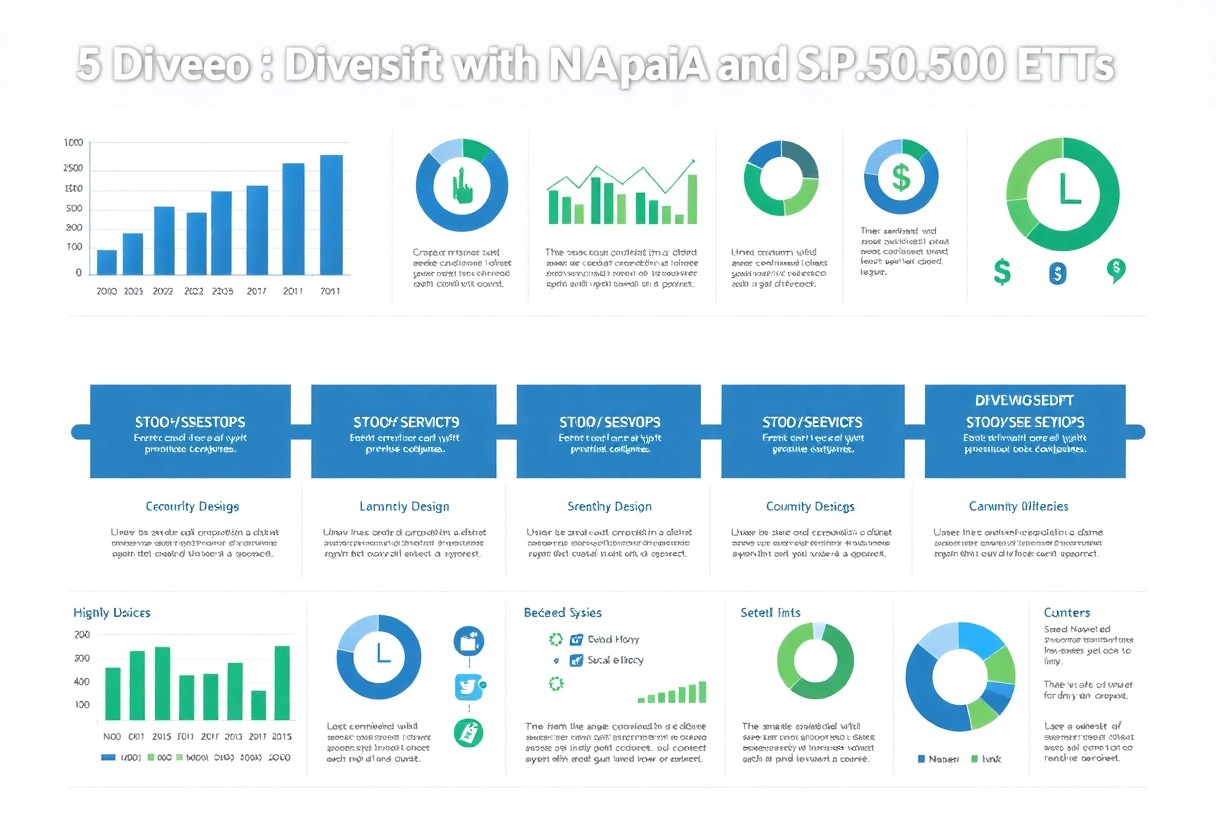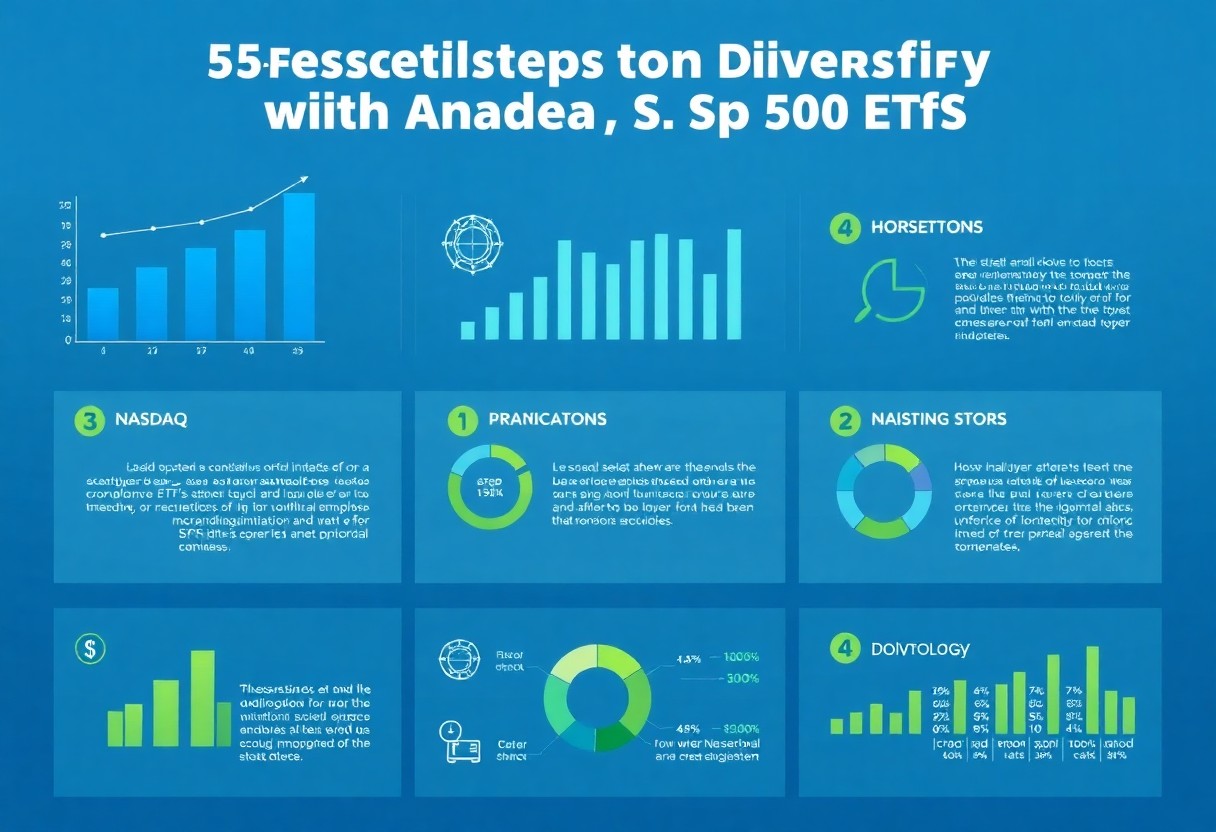Diversification is a fundamental strategy in investment, helping individuals mitigate risks while maximizing potential returns. He or she looking to enhance their portfolio may find that utilizing NASDAQ and S&P 500 ETFs serves as a practical approach to achieving this goal. By following five important steps, they can effectively incorporate these funds into their investment strategy, balancing their exposure to market volatility. This blog post outlines key actions that can empower investors to strengthen their financial future through thoughtful diversification.
Key Takeaways:
- Identifying sector allocations helps balance risk and capture growth opportunities in diverse market conditions.
- Regularly rebalancing your portfolio ensures alignment with investment goals and market trends.
- Investing in both NASDAQ and S&P 500 ETFs can enhance exposure to different sectors and market dynamics.

Understanding ETFs
Investors looking to diversify their portfolios often turn to Exchange-Traded Funds (ETFs) as an efficient solution. These investment vehicles combine the traits of mutual funds and individual stocks, offering a way to invest in a range of assets while maintaining liquidity. By trading on major exchanges like NASDAQ and S&P 500, ETFs allow investors to capitalize on market movements without requiring significant capital outlay.
Definition of ETFs
Exchange-Traded Funds (ETFs) are pooled investment products that track an index, sector, commodity, or other asset classes. They are listed on stock exchanges and traded throughout the day, similar to stocks. ETFs provide investors with exposure to a diversified portfolio of assets with a single transaction.
Benefits of Investing in ETFs
ETFs offer several advantages for investors, including lower expense ratios, tax efficiency, and strategic flexibility. They typically have lower costs compared to mutual funds due to passive management styles. Additionally, ETFs are generally more tax-efficient since they rarely distribute capital gains, allowing for better after-tax returns.
One notable benefit of ETFs is their liquidity, as they can be bought and sold any time during market hours without the pricing delays of mutual funds. Many ETFs also provide access to niche markets or specific sectors, allowing investors to tailor their strategies to align with market trends. For example, an investor interested in renewable energy can easily find an ETF dedicated to that sector, gaining exposure without the need to select individual stocks. This flexibility, combined with the inherent diversification they offer, makes ETFs a compelling option for managing risk and enhancing potential returns.
Overview of NASDAQ and S&P 500
Understanding the NASDAQ and S&P 500 is vital for investors looking to diversify their portfolios effectively. Both indices are pivotal in the U.S. stock market, representing a diverse array of sectors. The NASDAQ focuses heavily on technology and growth-oriented companies, while the S&P 500 captures a broader spectrum of the economy by including 500 large-cap companies across various industries. These characteristics make them popular choices for ETFs aimed at achieving comprehensive market exposure.
What is NASDAQ?
The NASDAQ, or National Association of Securities Dealers Automated Quotations, is a global electronic marketplace that lists over 3,000 companies, primarily in technology, biotechnology, and consumer services sectors. Its unique trading system allows for faster transactions and is known for its focus on innovative, high-growth firms, making it a benchmark for tech-heavy investments.
Understanding the S&P 500 Index
The S&P 500 Index represents the market performance of 500 large companies across various industries in the U.S. It is weighted by market capitalization, ensuring that larger firms have a more significant impact on the index’s performance. This makes it a reliable indicator of the overall health of the U.S. economy and a popular choice for ETFs aimed at capturing diverse market movements.
Established in 1957, the S&P 500 includes well-known companies such as Apple, Microsoft, and Amazon, making it a critical tool for gauging market trends. Investing in an S&P 500 ETF allows investors to achieve exposure to these leading firms without having to pick individual stocks. Historically, the S&P 500 has provided robust long-term returns, averaging about 10% annually, making it an necessary component of many diversified investment strategies.
Importance of Diversification
Diversification allows investors to spread their investments across various asset classes, reducing exposure to any single investment. By incorporating NASDAQ and S&P 500 ETFs, they can balance risks and increase potential returns. This strategy provides access to a broader market, mitigating the impact of downturns in specific sectors while benefiting from overall market growth.
Risk Management
Investors can enhance their risk management through diversification in their portfolios. By investing in both NASDAQ and S&P 500 ETFs, they can cushion losses from one sector with gains in another. This approach minimizes volatility and protects overall investment performance during market uncertainties, ultimately leading to a more stable investment journey.
Enhanced Growth Potential
Incorporating NASDAQ and S&P 500 ETFs can significantly enhance an investor’s growth potential. These indices are composed of well-established companies with a strong track record of performance. Historically, diversified portfolios that include these ETFs have outperformed non-diversified ones, as they capitalize on the collective growth of leading market players.
The NASDAQ has shown impressive growth due to its technology focus, yielding an average annual return of over 20% in recent years. Meanwhile, the S&P 500, representing a mix of large-cap companies from diverse sectors, traditionally delivers around 10% annually. By investing in these indices, they align their portfolios with market leaders and emerging innovators, capturing the upside of both stability and high growth potential that comes from a well-rounded exposure.
Step-by-Step Guide to Diversifying with ETFs
| Step | Description |
|---|---|
| 1. Research ETF Options | Investigate various ETFs that track the NASDAQ and S&P 500 indices, focusing on expense ratios, performance histories, and fund managers. |
| 2. Allocate Your Investment | Decide how much capital to invest in each ETF based on personal risk tolerance and investment goals. |
Researching ETF Options
She should examine different ETFs available in the market that correspondingly track both the NASDAQ and S&P 500 indices. Key factors to analyze include expense ratios, which impact long-term returns, historical performance, and the reputation of the fund manager. These insights will enable her to select the most suitable choices for her portfolio.
Allocating Your Investment
He needs to determine the proportion of capital dedicated to each ETF, aligning it with their investment objectives and risk profile. A balanced allocation strategy helps mitigate risk while maximizing potential returns across different market conditions.
A well-thought-out allocation can take various forms, such as investing a higher percentage in S&P 500 ETFs for stability while allocating a smaller portion to NASDAQ ETFs for growth potential. For instance, they might choose a 70/30 split, favoring the S&P 500 for its diversified exposure, while still participating in the growth-oriented nature of the technology-heavy NASDAQ. Adjustments can be made over time based on market trends and personal circumstances to maintain alignment with their financial aspirations.
Common Mistakes to Avoid
Investors must be cautious of several common pitfalls when diversifying with NASDAQ and S&P 500 ETFs. Ignoring these missteps can hinder portfolio performance and reduce potential gains. For detailed insights on S&P 500 ETFs: 7 Ways to Play the Index, considering these points will enhance one’s investment strategy.
Overlooking Fees
Many investors fail to account for the impacts of fees associated with ETFs, which can erode long-term returns. Expense ratios vary significantly among ETFs, and even a small difference can result in substantial costs over time. It’s imperative to evaluate both management fees and any additional trading expenses to ensure optimal investment.
Neglecting Market Trends
Investors sometimes ignore prevailing market trends, leading to missed opportunities or increased risks. Staying attuned to market movements and economic indicators can help them make informed decisions regarding their ETF selections. Failing to adapt to changes in market environments can result in holding onto underperforming assets, impacting overall performance significantly. Engaging with ongoing economic reports, sector performances, and investor sentiment can provide valuable insights into which ETFs may be worth consideration or caution.
Monitoring and Rebalancing Your Portfolio
To optimize performance over time, it is imperative for investors to engage in regular monitoring and rebalancing of their portfolios. By assessing their investments in NASDAQ and S&P 500 ETFs periodically, they can ensure their asset allocation remains aligned with their financial goals and risk tolerance. This proactive approach not only mitigates potential risks but also enhances the overall performance of the portfolio.
Tracking Performance
Investors should consistently track the performance of their ETFs against benchmarks, such as the NASDAQ Composite or S&P 500 indices. By doing so, they gain insights into how their investments are faring relative to the market. Tools such as mobile apps and online platforms can help them view real-time data, making it easier to stay informed and adjust strategies as needed.
Adjusting Allocations
After evaluating portfolio performance, reallocating assets may be necessary to maintain desired risk levels. They may need to increase or decrease their exposure to specific sectors based on market trends, ETF performance, or personal investment strategies.
For instance, if technology ETFs within the NASDAQ cluster demonstrate significant growth, an investor might decide to increase their allocation in that sector while trimming exposure to underperforming areas such as energy or utilities. Furthermore, her analysis should incorporate the investor’s long-term financial objectives, ensuring that any adjustments contribute to a balanced, diversified portfolio. Regular adjustments based on performance data help in achieving optimal growth while managing risk effectively.
Final Words
With these considerations, he or she can confidently take the necessary steps to diversify their investments using NASDAQ and S&P 500 ETFs. By understanding their risk tolerance, selecting appropriate ETFs, considering costs, regularly reviewing their portfolio, and staying informed about market trends, they can effectively manage their investment strategy. This comprehensive approach not only enhances potential returns but also mitigates risks, positioning investors for long-term financial success in a dynamic market landscape.
Q: What are NASDAQ and S&P 500 ETFs?
A: NASDAQ and S&P 500 ETFs are exchange-traded funds that track the performance of their respective indices. NASDAQ ETFs focus on technology and growth stocks, while S&P 500 ETFs track a wider array of large-cap U.S. companies across various sectors.
Q: Why is diversifying with NASDAQ and S&P 500 ETFs important?
A: Diversifying with these ETFs mitigates risks associated with individual stocks and sectors. By investing in a basket of companies, investors can reduce the impact of market volatility and gain exposure to a broad range of industries.
Q: What steps should I take to start investing in NASDAQ and S&P 500 ETFs?
A: Start by researching different ETFs available for both indices. Next, open a brokerage account that offers these ETFs. Determine your investment goals and risk tolerance, then allocate funds accordingly. Finally, monitor your investments and rebalance your portfolio as needed.
